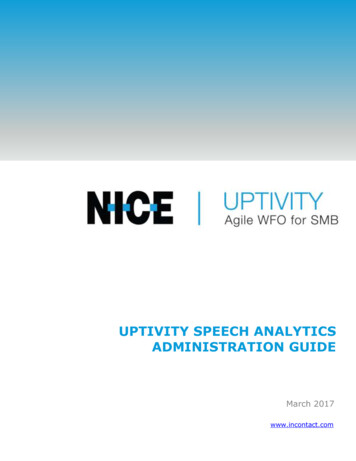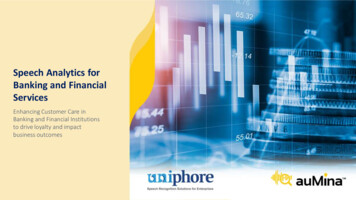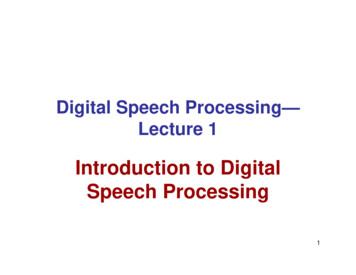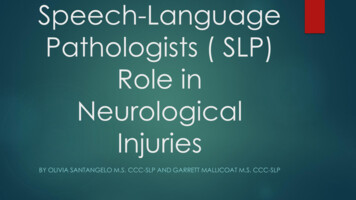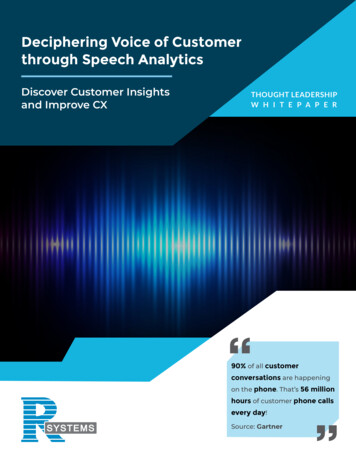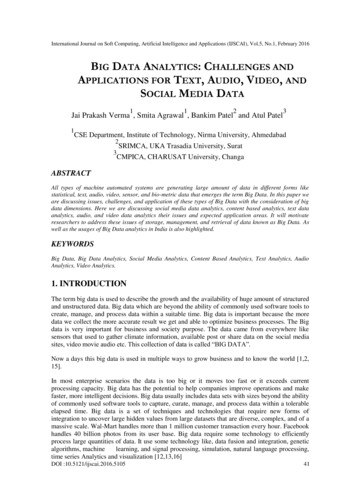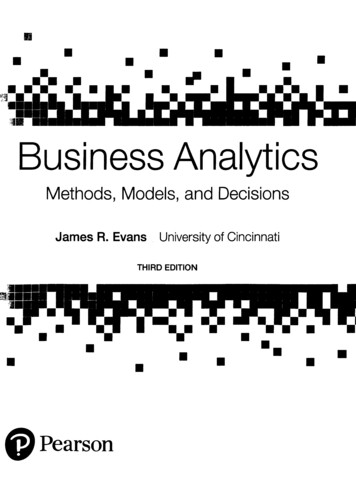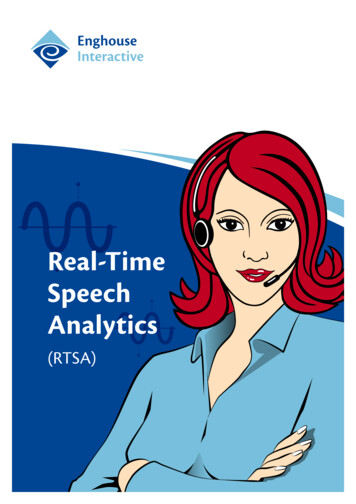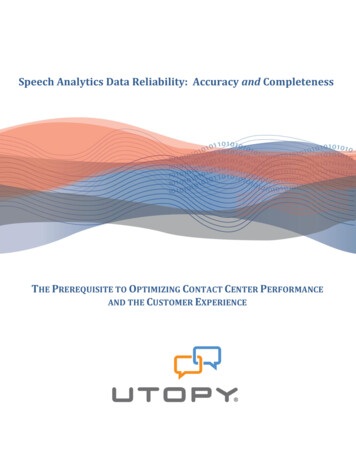
Transcription
Speech Analytics Data Reliability: Accuracy and CompletenessTHE PREREQUISITE TO OPTIMIZING CONTACT CENTER PERFORMANCEAND THE CUSTOMER EXPERIENCE
Summary of Contents (Click on any heading below to jump directly to that section):EXECUTIVE SUMMARYWHAT IS SPEECH ANALYTICS?THE UTOPY APPROACH TO SPEECH ANALYTICS SEARCH DISCOVERY CATEGORIZATIONDEFINITION OF DATA RELIABILITY: ACCURACY AND COMPLETENESS ACCURACY COMPLETENESS (HIGH DETECTION RATE)SPEECH ANALYTICS APPROACHES TRANSCRIPTION METHODS: SPEECH-TO-TEXT AND SPEECH-TO-PHONEME UTOPY’S PHRASE-BASED METHODOLOGY: THE MEANING OF SPEECHESSENTIAL FACTS TRANSCRIPTION METHODS PRODUCE INCOMPLETE DATA RESULTS FROM ACADEMIC STUDIES RESULTS FROM CUSTOMER TESTS UTOPY’S PHRASE-DRIVEN APPROACH: FIVE TO NINE TIMES MORE RELIABLETHE IMPORTANCE OF COMPLETENESS (HIGH DETECTION RATES) AGENT PERFORMANCE OPTIMIZATION: NEEDS IDENTIFICATION DIFFICULT WITH LOWDETECTION RATES MEASURING THE IMPACT OF TRAINING, COACHING OR POLICY CHANGES: TIME IS MONEY DECISION MAKING AND USER ADOPTION: DECISION-MAKERS CAN’T RELY ON ANECDOTALDATA COMPLIANCE: THE IMPACT OF MISSING “NON-COMPLIANT” EVENTS CUSTOMER SATISFACTION (CSAT) AND LOYALTY: THE ABILITY TO MAXIMIZE CSATINCREASES WITH THE AMOUNT OF CUSTOMER SENTIMENT DETECTED THE IMPORTANCE OF CONTEXT: PHRASES PROVIDE CONTEXT TO THE SPOKEN WORDCONCLUSIONPage 2www.utopy.com
Executive SummaryUTOPY's unique approach to Speech Analytics delivers business value in three different ways: search,discovery and categorization. Categorization delivers the highest business value of these three usagesbecause it is the most capable of automatically monitoring and optimizing contact center performance.UTOPY's patented phrase-driven direct speech analysis method delivers far better categorization thanany of its competitors due to the much higher level of data reliability which it delivers.Data reliability refers to the accuracy and completeness of data. Most Speech Analytics vendors willquote the accuracy of their product, but neglect to mention the completeness of the data when theproduct is tuned to the claimed accuracy level. In the realm of Speech Recognition and Analytics, usuallyas accuracy goes up, completeness goes down. However, the patented phrase-based methodologyemployed by UTOPY for speech categorization produces data that is much more complete compared to“transcription” methods at high levels of accuracy.The impact of this difference is multiplied if this data is to be used for the purposes of critical businessendeavors such as Contact Center Performance Optimization, regulatory compliance, or minimizingcustomer churn. Contact Center Performance Optimization requires reliable identification of thespecific topics that each agent finds difficult to handle, compliance requires reliable identification of rareoccurrences, and minimizing churn requires reliable identification of customer sentiment. Only UTOPY’sphrase-driven approach, which is five to nine times more reliable than the transcription approachesutilized by every other Speech Analytics vendor, is sufficiently reliable to drive applications whichoptimize contact center performance and the customer experience.What is Speech Analytics?Speech Analytics software takes free-flowing conversations between companies and their customers,analyzes those conversations and structures them into information that can then be leveraged forbusiness value.The UTOPY Approach to Speech AnalyticsUTOPY's unique approach to Speech Analytics delivers business value in three different ways: search,discovery and categorization.SearchSearch is the process of searching for words or phrases that have been spoken within calls, generally onan ad-hoc basis. Search is useful within many analysis workflows. Searches can be used for ad-hocexploration of conversation content or to test hypotheses.UTOPY delivers Speech-to-Text transcription using a Large Vocabulary Speech Recognition (LVCSR)engine. This Speech-to-Text transcription powers UTOPY’s text driven search engine, which enables adhoc word searches and exploration. Search results are sorted by relevancy and speech recognitionaccuracy.Page 3www.utopy.com
DiscoveryDiscovery uncovers current trends or events occurring within conversations—trends or events which anorganization may not have previously been aware of. Discovery can be useful for uncovering importantevents or issues before they become major problems for the organization.UTOPY offers various discovery analytics which are powered by the UTOPY Speech-to-Text engine.These discovery analytics uncover informative current trends or occurrences within calls and proactivelynotify the organization of these current issues or topics.CategorizationCategorization is the process of categorizing calls based upon the reason for the call, the topics thatwere discussed during the call, and/or any events which occurred during the call. Of the three SpeechAnalytics use cases which UTOPY enables, categorization delivers the highest business value because itdiscovers the call reasons, agents, products or processes which are driving performance on contactcenter Key Performance Indicators (KPIs). UTOPY categorizes calls based upon the phrases spokenwithin the calls. UTOPY's patented phrase-driven direct speech analysis method delivers far better andmore valuable categorization than any of its competitors due to the much higher level of data reliabilitywhich it delivers.Definition of Data Reliability: Accuracy and CompletenessAccording to the US Government Accountability Office1, “data reliability refers to the accuracy andcompleteness of computer-processed data, given the uses they are intended for.” In the realm ofSpeech Recognition and Analytics, “completeness” is measured by the “detection rate”, and usually asaccuracy goes up, the detection rate goes down.AccuracyAccording to the American Heritage Dictionary of the English Language, accuracy is defined as: “Theability of a measurement to match the actual value of the quantity being measured.” In the realm ofSpeech Recognition and Analytics, accuracy refers to the portion of results that were correctlyrecognized within a given result set.The concept of accuracy can be illustrated in laymen’s terms by the following example. An executive inSan Francisco needs to attend a meeting in New York. The executive calls the company travel agent, andasks the travel agent to e-mail him a list of all the flights from San Francisco to New York. The travelagent e-mails the executive a list of ten flights, but one of the flights is from Oakland to Newark, whilethe rest of the flights are from San Francisco to New York as the executive requested. Nine out of ten is90% accuracy.Completeness (High Detection Rate)Completeness is defined as: “The state of being complete and entire; having everything that is needed.”In the realm of Speech Recognition and Analytics, completeness is measured by the detection rate, and1US Government Accountability Office: “Assessing the Reliability of Computer-Processed Data” (Report# GAO-09680G), July 2009Page 4www.utopy.com
detection rate refers to the portion of occurrences of a given event or word found by the systemcompared to the actual number of occurrences. Throughout the remainder of this paper, we usecompleteness and high detection rate interchangeably, as they have the same meaning.To continue with our previous travel agency example, imagine that after the executive receives the listof flights from the travel agent, the executive sits down at his computer, goes to an online travelwebsite, and searches for flights from San Francisco to New York. His search returns 18 flights from SanFrancisco to New York. The list from the travel agent had only 9 of those flights. The travel agent hadonly found nine out of the 18 flights from San Francisco to New York—a 50% detection rate.Needless to say, data reliability is critical to sound decision making (see The Importance ofCompleteness for details). However, most Speech Analytics vendors neglect to mention their detectionrates when discussing the reliability of their data, instead quoting their accuracy rates, even though theirdetection rates go down significantly as their accuracy goes up. Throughout the rest of this paper, weprovide the results of various tests done by independent third parties which prove that transcriptionmethods of Speech Analytics produce incomplete data.Speech Analytics ApproachesTranscription Methods: Speech-to-Text and Speech-to-PhonemeMost Speech Analytics products use Speech-to-Text or Speech-to-Phoneme (also known as Phonetic)conversion methods. In these approaches, a speech recognition engine transcribes the audio intocollections of words or phonemes (the smallest discreet unit of human speech), and then a text miningor search engine attempts to spot keywords—or combinations of keywords— in the converted text orphonemes.These approaches enable rapid ad-hoc searches and exploration of unstructured audio data, which iswhy UTOPY utilizes a Speech-to-Text conversion engine to power its speech search and discoverycapabilities.However, data is permanently lost during the conversion process due to the inherent limitations ofcurrent speech recognition and conversion engines, and the context in which the words were used (andtherefore the business impact or outcome) is very difficult to capture using such a keyword-spottingapproach.UTOPY’s Phrase-Based Methodology: The Meaning of SpeechIn contrast, the patented, phrase-driven UTOPY approach to speech categorization and analysiscombines speech and business concept recognition into a single-step.By directly recognizing and analyzing entire phrases, UTOPY’s patented method is automatically tailoredto specific business needs and industry specific terminology, making it an order of magnitude morereliable at recognizing speech that is relevant in a business context than other solutions in the markettoday. Transcription approaches, which only recognize individual words or phonemes, must customizetheir entire language models in order to address such particular business needs.Page 5www.utopy.com
Furthermore, entire phrases are much better than smaller recognition units at compensating for themispronunciations, utterances and other speech disfluencies2 common in everyday speech.The result is a holistic approach to precisely and completely understanding and analyzing the entirety ofthe interactions taking place between companies and their customers, and an exponential increase indata reliability and business value.Essential FactsTranscription Methods Produce Incomplete DataSpeech-to-Text and Speech-to-Phoneme products can be tuned to be relatively accurate, but theirdetection rates suffer as a result. Only UTOPY’s patented phrase-driven direct speech recognition andanalysis technology is able to maintain a high detection rate at high accuracy levels, as Table 1 belowillustrates.Speech Recognition EnginePhrase-DrivenSpeech-to-TextPhoneticUnit of Speech RecognitionPhrasesWordsPhonemesTypical Deployed Accuracy85-95%80-85%80-85%Tuned to the same accuracy, what is the detection rate (completeness) out of 10 events?Accuracy80% accuracy80% accuracy80% accuracyDetection (completeness)70% detection10% detection5% detection10 events9 results1-2 results0 results10 events7 true events found1 true event found0 true events foundTable 1: A comparison of the various Speech Analytics approachesTable 1 assumes that 10 events have occurred within a set of calls. When tuned to 80% accuracy, thedetection rate of UTOPY’s phrase-driven direct speech recognition and analysis method is 70%, thedetection rate of UTOPY’s Speech-to-Text conversion method is just 10%; and the Phonetic method hasonly a 5% detection rate. Therefore, of those 10 events that have occurred, UTOPY’s phrase-drivenmethod will accurately detect 7, while its Speech-to-Text method might only accurately detect 1, andthe Phonetic method may not accurately detect any events!2See http://en.wikipedia.org/wiki/Disfluencies for the definition of Speech DisfluenciesPage 6www.utopy.com
Results from Academic StudiesVarious academic studies have proven that transcription methods of Speech Recognition and Analyticshave low data reliability. For example, according to a recent, well established study3, when used withreal-world call center data, the Speech-to-Text method is only around 40-50% correct at the individualword level. This means that at least half of the actual words spoken are either not recognized, or arerecognized incorrectly. It is an established fact that phoneme recognition is at least 10-20% less reliablethan Speech-to-Text due to the small size of the recognition unit. In another well-known study4, eightleading speech research groups, including Cambridge University, AT&T, SRI, BBN, and John HopkinsUniversity, participated in a National Institute of Standards (NIST) evaluation of telephony speech wordrecognition. Their results show significantly worse performance on the phoneme level as compared tothe word level. Considering this compelling research, we can conclude that Speech-to-Phonemereliability is at best around 30-40%. This means that two out of three phonemes are either notrecognized, or are recognized incorrectly.In contrast, UTOPY’s phrase-driven method is significantly more reliable than its Speech-to-Textconversion method and dramatically more reliable than the Speech-to-Phoneme method at theindividual word level. These differences become even more dramatic at the level of business topics,because business concepts are generally verbalized in phrases.Consider, for example, a phrase made up of three keywords, such as “didn’t receive (a) bill”. Let’sassume 50% reliability for each individual word, which is the best rate established by the abovementioned studies for transcription methods. If we multiply the probability of correctly recognizing allthree words together (50% x 50% x 50%), we find that the probability of correctly recognizing an entirethree word phrase is only 12.5%, meaning that nearly nine out of ten times, the entire phrase will not becorrectly recognized!Results from Customer TestsThe fact that UTOPY’s phrase-driven approach is much more reliable than transcription methods hasalso been independently verified by the results of side-by-side tests that prospects have conductedbetween UTOPY and competitors who use transcription methods (Speech-to-Phoneme or Speech-toText).In the example illustrated by the following chart, UTOPY and a competitor were both given the same setof calls and were asked to find specific statements made by call center agents or customers on thosecalls. The number of such occurrences properly recognized by each vendor is illustrated in the chart inFigure 1.3Min Tang, Bryan Pellom and Kadri Hacioglu, “Call-Type Classification and Unsupervised Training for the CallCenter Domain”, University of Colorado at Boulder4Shuangyu Chang and Steven Greenberg , “Linguistic Dissection of Switchboard-corpus Automatic SpeechRecognition Systems,” University of California, BerkeleyPage 7www.utopy.com
Actual prospect side-by-side test results250UTOPYCompetition236202200150# CorrectlyRecognized10014910950122456370No PrepaymentPenaltyNo Lender FeesCallback ScheduledAgent StatementCaller HoldRequestedFigure 1: Results from a side-by-side test conducted by a prospectUTOPY’s Phrase-Driven Approach: Five to Nine Times More ReliableThis customer test and others undeniably confirmed that UTOPY’s phrase-driven approach is five to ninetimes more reliable than transcription approaches. For example, in the test illustrated in Figure 1 above,UTOPY correctly recognized more than nine times as many phrases related to the topic “No PrepaymentPenalty”.This fact was also confirmed by rigorous testing that UTOPY performed on the three different SpeechAnalytics methods. The results of these tests are shown in the following chart (Figure 2).Page 8www.utopy.com
Data Reliability to-Text0.50-0.5-0.500.511.5DetectionFigure 2: Data Reliability Comparison between the various Speech Analytics approachesThese tests confirmed that at low rates of detection, all three methods can be tuned to be highlyaccurate. However, as detection goes up, accuracy generally goes down. As illustrated by the chart, therate of degradation in reliability at higher detection rates is dramatically worse for the Speech-to-Textand Phonetic transcription methods compared to UTOPY’s phrase-driven direct speech recognition andanalysis approach. For example, at a detection rate of 70%, UTOPY’s phrase-driven approach is 82%accurate, while Speech-to-Text is only 11% accurate at that detection rate, and Phonetic is only 6%accurate at that detection rate.The Importance of Completeness (High Detection Rates)Agent Performance Optimization: Needs identification difficult with low detection ratesThe impact of these differences is multiplied if Speech Analytics data is to be used for the purposes ofcritical business endeavors, such as agent performance optimization, which require at least two furtherlevels of detail. For example, in order to improve First Call Resolution, we would need to find out whattypes of customer questions are prompting which agents to schedule callbacks. UTOPY preciselyuncovers such granular correlations, and then automatically leverages this knowledge to recommendthe best actions to improve business performance.In the side-by-side test illustrated previously (in Figure 1), UTOPY correctly identified 149 callbacks thatwere scheduled, while the competition only correctly identified 37. In this case, five different agentshandled this particular set of calls, and the calls were for three different call reasons. Each call reasonhad an average of five different sub-topics. Dividing the 149 calls with callbacks scheduled identified byUTOPY evenly between the five agents, three call reasons and five sub-topics, there would be twocorrectly identified calls per agent per sub-topic. If we make the same calculation on the 37 callsUTOPY’s competitor correctly identified, the result is .5 --- ½ of a call per agent per sub-topic correctlyidentified on average by the transcription method. Obviously, it is much easier to identify what types ofquestions are prompting which agents to schedule callbacks with two calls per agent per sub-topicPage 9www.utopy.com
compared to ½ a call per agent per sub-topic. UTOPY leverages this more reliable data to automaticallyidentify which customer issue(s) each agent has difficulty resolving on the first call from the customer,and UTOPY automatically recommends the best action(s) to take to improve each agent’s knowledge ofthe particular topic(s), recommending, for example, specific coaching, training or e-Learning for eachparticular sub-topic.Measuring the Impact of Training, Coaching or Policy Changes: Time is MoneyWhen changes are made to training/coaching programs or business policies in order to improve contactcenter performance and the customer experience, UTOPY immediately measures and continuouslymonitors the impact of such changes. Because of the high level of Speech Analytics data reliability itdelivers, UTOPY can measure the impact of such changes in much less time with much less data than thecompetition. Since their data reliability is five to nine times lower than UTOPY, competitors require fiveto nine times more calls (data) to analyze in order to uncover the same information. Much more time isrequired for a typical contact center to make or receive so many more calls.Decision Making and User Adoption: Decision-makers can’t rely on anecdotal dataDecision-makers shouldn’t rely on analytics or reports if they are based on data that is not complete. Ifthe data is not reliable, people will not trust or use any calculations, reports or other analysis that isbased upon that data.Compliance: The Impact of Missing “Non-Compliant” EventsAdherence to regulatory or enterprise policies and procedures is a prerequisite to being in business inmany industries today. The majority of a company’s interactions with its customers will complyperfectly with such regulations. However, the occurrence of even a single non-compliant event, nomatter how rare such an occurrence is, could cause extensive litigation and other trouble and expensefor a company. It is mission-critical in such situations to detect and correct every single occurrence of a“non-compliant” event.Customer Satisfaction (CSAT) and Loyalty: The ability to maximize CSAT increases with theamount of customer sentiment detectedCustomer satisfaction can be difficult to measure, yet any increase in satisfaction means acorresponding increase in customer loyalty and up-sell/cross-sell potential. In order to increasecustomer satisfaction, all available customer sentiment must first be reliably detected and measured.Any customer dissatisfaction must be detected, the reasons for that dissatisfaction must be completelyand accurately uncovered, and then proactive action must be taken to improve satisfaction levels. Forexample, each unhappy customer should be identified and proactively contacted in an attempt to keepthat customer’s business.The Importance of Context: Phrases provide context to the spoken wordA single word can be used in a myriad of different ways, with many different meanings. For example,the word “bill” could refer to: a person named “Bill”; or could be part of a request to speak to the“Billing” Department; or could be someone saying that they didn’t get a “bill”; or that he/she refuses topay a “bill”. These differences in meaning are very important, yet only the entire phrase provides thePage 10www.utopy.com
context which enables true understanding of the real meaning of the word. Only UTOPY’s phrase-basedmethodology delivers the true meaning of speech.ConclusionReliable Speech Analytics data, which is accurate, complete and delivered in its business context, is theprerequisite to optimizing contact center performance and the customer experience. UTOPY’s highlyreliable data foundation enables targeted business applications which produce actionable information,driving best practice workflows for optimizing business performance, and propelling UTOPY towards theopposite end of the business value continuum from the rest of the Speech Analytics vendors, whosetechnology is exclusively transcription based.Page 11www.utopy.com
Most Speech Analytics vendors will quote the accuracy of their product, but neglect to mention the completeness of the data when the product is tuned to the claimed accuracy level. In the realm of Speech Recognition and Analytics, usually as accuracy goes up, completeness goes down. However, the patented phrase-based methodology
